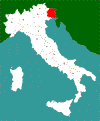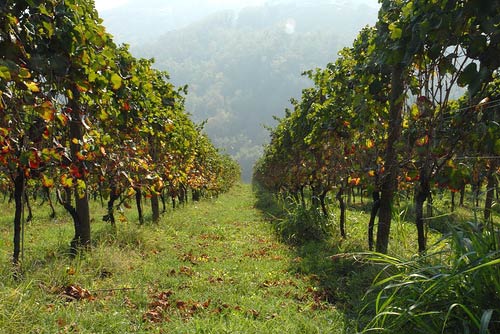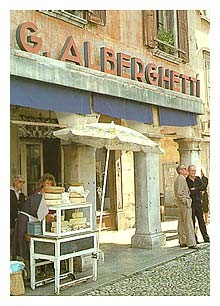North West Italy
Friuli-Venezia Giulia
Primary grape varieties:
White Grapes:Tocai Friuliano, Chardonnay, Sauvignon, Pinot Grigio, Pinot Bianco, Ribolla Gialla, Picolit, Verduzzo, Malvasia, Moscato Giallo, Muller Thurgau, Riesling Renano
Red Grapes:Merlot, Cabernet Franc, Cabernet Sauvignon, Refosco, Schioppettino, Tazzelenghe, Pinot Nero Situated in the north-easternmost corner of Italy, Friuli-Venezia Giulia is a small region bordering Austria to the north and Slovenia to the east. It's thought that the vine was originally brought here from the east, long before it ever got to France. No doubt Friuli's geographical position coupled with a tumultuous and ethnically diverse history have helped to ensure the large number of varietals now associated with the region's vine covered hills. The names 'Friuli' and 'Giulia' refer to Julius Caesar and his conquest of the territory, which, at the time, separated east from west. The region was also a part of the Austro Hungarian empire before joining Italy in the 1800's. (More recently, the devastation of World war II resulted in parts of Collio, including some of the best vineyards, being conceded to the then Yugoslavia).
Situated in the north-easternmost corner of Italy, Friuli-Venezia Giulia is a small region bordering Austria to the north and Slovenia to the east. It's thought that the vine was originally brought here from the east, long before it ever got to France. No doubt Friuli's geographical position coupled with a tumultuous and ethnically diverse history have helped to ensure the large number of varietals now associated with the region's vine covered hills. The names 'Friuli' and 'Giulia' refer to Julius Caesar and his conquest of the territory, which, at the time, separated east from west. The region was also a part of the Austro Hungarian empire before joining Italy in the 1800's. (More recently, the devastation of World war II resulted in parts of Collio, including some of the best vineyards, being conceded to the then Yugoslavia).
Friuli-Venezia Giulia is blessed with a climate and geology that is particularly beneficial for white wines (though some good red can be found as well). The interplay between the Alps and the Adriatic creates a mild and breezy climate that cools the vineyards in the hot summer. Vines receive excellent sun exposure combined with cooling breezes that keep the grapes mould free and help prevent over ripening. For the most part winters are mild. Today Friulian wines represent approximately two percent of Italy's total production. Its best wines have been compared to those produced in two celebrated wine producing regions, Piedmont and Tuscany. The main difference between the regions is that Friuli wines are mostly white.

Friuli is also remarkable for the sheer number of grape varieties that can find their way into its blends, which include a mixture of international and indigenous grape vines like Chardonnay, Riesling, Sauvignon, Tocai Friulano, Pinot Grigio, Pinot Blanc, Vitovska, Picolit, Malvasia Istriana and Ribolla Gialla to name a few. Adding to the confusion are the large range of wines often produced by single estates. Thankfully for consumers, red and white wines are mostly named after the grape varieties from which they are made, in conjunction with the basic Denomination of Origin that is derived from the name of the locality or zone where they are produced.
The region is divided into four provinces: Gorizia, Pordenone, Trieste and Udine. The two most prominent wine zones are Collio and Colli Orientali del Friuli, both lying in the hills along the eastern border. Collio is a small hilly area bordering Slovenia, that gives its name to a white, dry, balanced wine with a slight sparkle, as well as the other seven white and three red wines named after as many grape varieties. The Colli Orientali Del Friuli, the eastern hills of Friuli, produce twelve white and eight red varietal wines. Among the whites is 'Picolit', a deep straw colour, delicately scented, sweet wine and one of the 'aristocratic' dessert wines of Italy. It once ranked as one of Europe's finest sweet wines, when it was favoured by the Hapsburgs and other royal families during the early 19th Century. (For most of this century, the picolot vine suffered a catastrophic genetic disease so that it failed to produce berries. By crossing it with other vines, it appears a solution has been found and the wine is once again regularly available). Verduzzo, also makes a refined dessert wines in Colli Orientali from a place called Ramandolo.
Merlot, Cabernet Franc, Pinot Nero and Refosco are the dominant red varietals in Fruili. Traditionally light and fruity, these wines, with the application of modern techniques, are also becoming more interesting. Other styles include Grave del Friuli - comprising six red, eight white and a rosé; Tocai Friulano, which is a distant relative of Sauvignon Blanc, has variations from medium and fresh to full and unctuous. Its drier, minerally expression is a classic match with the local prosciutto and cured meats. Currently, there is controversy regarding the name of this varietal, and the EU has demanded it changed to avoid confusion with the famous Tokay dessert wine from Hungary. Another zone, Isonzo, is named after a river by the same name which has eleven white and eight red. Some fifty miles above Venice is a town called Latisana that gives its name to five red, seven white and a rosé, all, like the others, known by the name of the grape variety they come from.
Other styles include Grave del Friuli - comprising six red, eight white and a rosé; Tocai Friulano, which is a distant relative of Sauvignon Blanc, has variations from medium and fresh to full and unctuous. Its drier, minerally expression is a classic match with the local prosciutto and cured meats. Currently, there is controversy regarding the name of this varietal, and the EU has demanded it changed to avoid confusion with the famous Tokay dessert wine from Hungary. Another zone, Isonzo, is named after a river by the same name which has eleven white and eight red. Some fifty miles above Venice is a town called Latisana that gives its name to five red, seven white and a rosé, all, like the others, known by the name of the grape variety they come from.
Quality has not always been pursued in Fruili. In fact, it is only in the last 40 years that the region has become an Italian leader, successfully incorporating modern wine making techniques into traditional contexts. Friulian white wines were re-invented in the 1960's and 1970's with an early push away from mass production. In many ways, these wines and their makers were the trendsetters in the rebirth of Italian wine as products of quality in the international market place.
